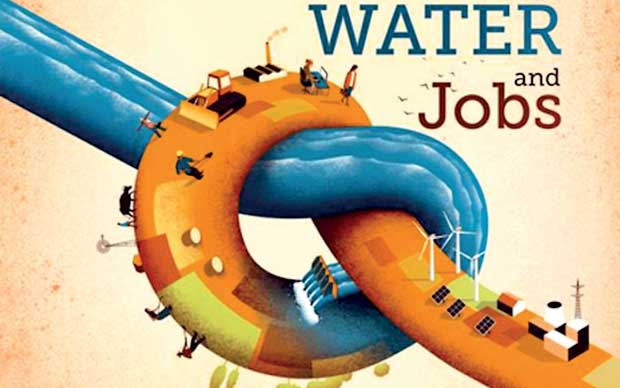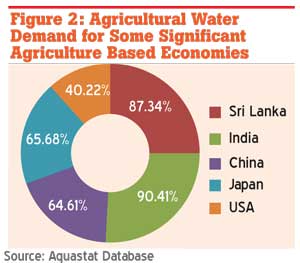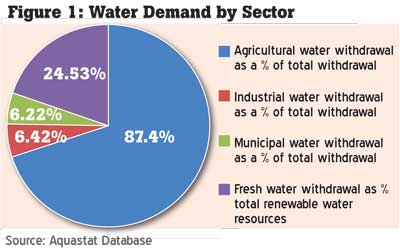23 Mar 2016 - {{hitsCtrl.values.hits}}

By Chatura Rodrigo and Athula Senaratne
March 22 marks the World Water Day 2016 under the theme ‘Water and jobs’. The theme focuses on how enough quantity and quality of water can change workers’ lives and livelihoods - and even transform societies and economies. In this article to mark the day, IPS Researchers Chatura Rodrigo and Athula Senaratne explore the challenges faced by agricultural livelihoods, which employ a majority of Sri Lanka’s rural sector and identifies measures to overcome such challenges.
Water is vital in many forms of livelihoods. In agriculture too, there’s a tremendous need for the direct access to water. Water in terms of quality and quantity has a great impact on agricultural production. In Sri Lanka, agriculture accounts for a majority of employment. Better quality water for agriculture in adequate amounts has been a main concern in the country since ancient times, leading to various developments in water resources management.

A sufficient supply of quality water leads to successful harvests, which results in good farm income and increased quality of life. However, the quality as well as the quantity of water for agriculture now seems to be reducing, threatening the livelihoods of farmers. Therefore, it is important to understand the water quality and quantity-related challenges in agricultural livelihoods and identify the measures to overcome these challenges.
Decrease in the water quantity is a major concern
Demand for agricultural water is higher than industrial and municipal water demands. Figure 1 shows the fresh water withdrawals in Sri Lanka. Approximately, 87.34 percent of freshwater withdrawals are used for agricultural purposes.
The share of agricultural water demand is higher in Sri Lanka when compared to many other countries in the world. Figure 2 shows that Sri Lanka’s water demand for agriculture is only second to India among the selected countries. The reasons for the increase in demand for water could be the low efficiency of water use in farms, poor adoption of water saving techniques, high losses associated with storage, distribution and on-farm utilization of water and the lack of incentives for conservation due to free state supply of irrigation. In most developed countries, the adoption of technological advances and market-based strategies has reduced the water demand for farming.

According to the current statistics, the total cultivated area in Sri Lanka is estimated at 1.86 million ha. About 632,000 ha of the area are irrigated and the rest is rain-fed. Irrigated agriculture mainly comprises of major irrigation schemes. In addition, there are numerous minor schemes, which can be identified as semi rain-fed systems. They include over 15,000 village tanks scattered across the country’s dry zone areas. Irrigated agriculture received a great deal of attention of policymakers over the last several decades, which culminated in the accelerated Mahaweli Development Programme in the mid-1980s. Many steps have been taken to rehabilitate and restore ancient irrigation systems.
A majority of irrigated land in the country is used for paddy cultivation. The demand for water is high in paddy cultivation compared to many other crops. Water is essential for the preparation of land and the planting and maintenance of the crop throughout the planting-harvest cycle. On average, the water requirement for irrigated rice is between 900-2250 mm per day. By 2025, paddy cultivation area is projected to increase by 28 percent, with the annual growth in the cultivated area of paddy rising to 1077 ha, compared to 836 ha in 1991.
The dry zone is the main paddy producing area in the country and some parts of this area will face an absolute scarcity of water by 2025. Furthermore, research suggests that paddy production will increase by 10 percent by year 2025 and that additional amount will be totally irrigation-based.
There is increasing evidence to suggest that water scarcity is likely to be aggravated further by the inevitable reality of climate change. The Intergovernmental Panel on Climate Change (IPCC) suggests that climate change affects all components of freshwater systems. As a result, water quality and availability will be major issues in the future. The established patterns of rainfall have changed and the distribution of rainfall in different parts of the country also appears to be undergoing changes. While droughts cause delays in planting seasons and are responsible for crop damages - floods have been destroying mature crops awaiting harvest.
Water quality cannot be ignored
Not only the quantity but the quality of water also affects crop growth and harvest, which also determines the farmer income. Both surface and ground water sources have been affected by various pollutants and other contaminants reducing the quality of water available for agricultural livelihoods as well as domestic use of the farming community. The surface water contamination in Sri Lanka is mainly due to agriculture runoff, improper disposal of sewage, unmanaged waste from industries, livestock, etc., and inadequate sanitary facilities. The agricultural runoff, which comes from non-point sources, consists of pesticides, nutrients, suspended solids and organic material that makes the water unusable for agricultural purposes.
Groundwater is available from both shallow and deep aquifers. Shallow aquifers -generally located less than 50 feet below soil surface - are the most intensely utilized aquifers and have a higher possibility of being exposed to ground water contamination. Higher concentrations of heavy metals, nutrients such as nitrate and phosphates from agrochemicals and fertilizers, brackish water intrusion as a result of uncontrolled abstraction of groundwater for domestic and agricultural use, pathogenic bacteria from pit latrines are among the main causes of ground water pollution.
There are many incidents of groundwater contamination reported from various sources that reduce the amount available for agricultural and domestic purposes. High concentrations of arsenic such as 35mg/L (WHO standard 10mg/L) have been found in dug wells at a few locations in the country. Sewage pollution has increased the nitrate concentration up to the range of 122 to 174 mg/L in some areas of Point Pedro. Eppawla and Anuradhapura reported the highest fluoride concentration as 9mg/L while 15 percent of tube wells located in the Polonnaruwa District have shown fluoride concentrations above 2mg/L.
Elevated concentrations of chloride, nitrate and potassium are observed in many irrigation wells in the Kalpitiya and Jaffna peninsulas, with nitrate concentrations of up to 40 mg/L due to higher consumption of agro chemicals in crop cultivation. About 40 percent of dug tube wells for domestic and agriculture usage during last decade are abandoned due to contamination with iron, manganese, fluoride and subsidence of water level.
Managing agricultural water to ensure sustainable livelihoods
Water management in agriculture involves many different functions that are also closely associated with the management of other natural resources. Accordingly, water management depends on the actions of different users of water and other natural resources. For example, water management for agriculture from an irrigation tank largely depends on the management of the catchment area of the tank.
The actions of users of the catchment area will affect water storage, thereby determining the availability of water for agriculture. Therefore, integrated approaches are necessary for managing scarce water resources for agricultural and other competing purposes (e.g., domestic, industrial). Such approaches are broadly identified as Integrated Water Resource Management (IWRM).
Water-scarce countries can increase the efficiency of their water management practices through new technological/institutional strategies and water conservation. They can use more efficient, economical and environmentally-friendly approaches to prevent water pollution. It has been demonstrated that naturally unusable water such as saline and sodic water can be used in agriculture with the application of new technologies.
However, such strategies should be compatible with country-specific needs and development agendas. With the emerging technologies and private sector involvement, agricultural water management has become increasingly complex. Countries such as the USA, China, Japan and Germany appear to have placed more faith on larger investments and modern technologies, while developing countries are focusing on adopting an IWRM approach.
One innovative concept is ‘virtual water’. Virtual water refers to the hidden or unobserved flow of water when commodities are traded from one country to another. The virtual water content of a commodity is the volume of water required to produce the commodity, which is measured at the original place of production. This contains the quantity of water used for that commodity at various stages of the production process.
Therefore, if a country with scarce water resources is producing a particular commodity, which requires a large water quantity, then they could potentially import that commodity from another country that has relatively less water issues and save the water needed to produce that commodity for alternative purposes that can be achieved more efficiently.
Both point and diffused sources of pollution can affect the quality of water. Typically, 50 percent to 90 percent of pesticide pollution in ground and surface water comes from point pollution sources in agriculture - for example, spillages, incorrect cleaning of spraying equipment or illegal disposal of leftover spray solutions. Diffused water pollution through pesticides occurs due to spray drift, surface runoff, drainage losses or leaching to groundwater. These incidents can be avoided through adopting good agricultural practices.
In all regions of the world, avoiding point pollution sources is the first and most effective step to maintain water quality. Implementing best practices, can evade pollution and a significant improvement of water quality in agricultural catchments can be achieved. Adopting appropriate risk reduction measures such as establishing vegetated buffer strips alongside surface water bodies can further reduce risks.
(Chatura Rodrigo is a Research Economist at the Institute of Policy Studies of Sri Lanka (IPS) and Athula Senaratne is a Research Fellow and the Head of the IPS Environmental Economic Policy Unit. To view the article online and comment, visit the IPS blog ‘Talking Economics’ – www.ips.lk/talkingeconomics)
24 Nov 2024 4 hours ago
24 Nov 2024 7 hours ago
24 Nov 2024 8 hours ago
24 Nov 2024 8 hours ago